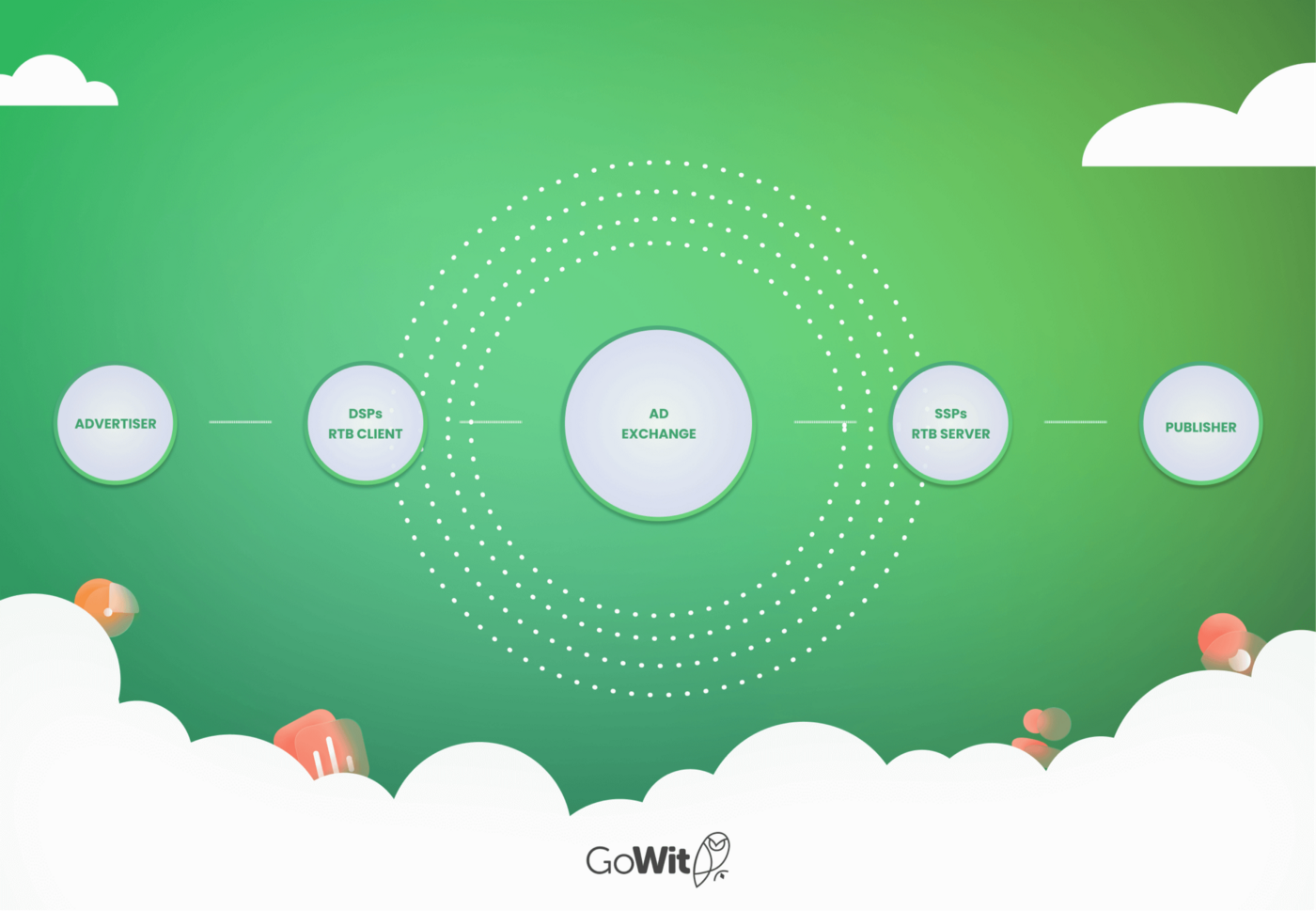Programmatic Advertising Essentials: What Is An Ad Exchange?
Digital Advertising
.
6 min read
An ad exchange is a digital platform where advertisers and publishers can buy and sell ads programmatically and transparently.

Programmatic Advertising 101
In earlier times, digital advertising transactions between publishers and advertisers relied on email communication. However, as the digital advertising landscape expanded significantly, managing the increasing number of advertisers and publishers through traditional methods became cumbersome and labor-intensive. This paved the way for the emergence of 'programmatic advertising.' This innovative approach revolutionized ad trading, offering speed, efficiency, and enhanced security. The advent of programmatic advertising has swiftly transformed the advertising industry by streamlining processes for faster, more efficient, and safer ad transactions.
Definition Of Programmatic Advertising
Online ad trading leverages advanced advertising technology (AdTech) to enhance capabilities, orchestrating a transparent, swift, and precise dynamic process. Powered by algorithms and software, this approach ensures efficient management, minimizing errors and time consumption through automated auctions. Programmatic advertising harnesses user data from browsers, encompassing cookies, IP, and pixel tags, meticulously analyzing user behaviors and preferences. This enables precise targeting options for both SSP and DSP sides, ensuring highly relevant ad experiences for visitors. Moreover, it opens diverse opportunities for brands, including reaching potential customers, elevating interaction rates, refining marketing strategies, and bolstering brand awareness. These distinctive features have propelled programmatic advertising to a prominent position in the digital market share.
How Does Programmatic Advertising Function?
Programmatic advertising operates as a seamless transaction between publishers offering available ad space and advertisers or ad networks seeking to purchase online ad inventory. This innovative platform serves as a hub, uniting diverse potential advertisers and publishers with the primary aim of facilitating an optimal match for heightened efficiency. In essence, the process revolves around three key components: SSP (Supply-Side Platforms), Ad Exchange, and DSP (Demand-Side Platforms).
What Is An Ad Exchange?
An ad exchange is a digital platform where advertisers and publishers can buy and sell ads programmatically and transparently. Since ad tech breakthrough, It is a piece of advertising technology that aims to match advertiser’s display, video, audio, and native ad inventory with ad spaces on publisher’s apps or websites. Thanks to the advantages it provides, such as profit maximization and management of the process, it has a critical position in the online advertising market.
Who Uses An Ad Exchange?
Ad Exchange for Advertisers: Advertisers aim to deliver their inventory to the right users in the right online areas. Accordingly, they manage the ad purchasing process using DSP (Demand-Side Platform). Advertisers connect to Ad Exchange with DSP. As a result, high success is achieved in accessing a large pool of publishers, reaching the target audience at the right moment, and increasing the awareness of the brand.
Ad Exchange for Publishers: Publishers have ad spaces on their blog, website, online magazine, mobile app, and game. The main objective is to earn the maximum income from the ad spaces they have. Accordingly, they manage their ad spaces using SSP (Supply-Side Platform). What is more, publishers can connect to Ad Exchange with SSP and they can reach a large pool of advertisers.

How Does An Ad Exchange Work?
When a publisher wants to evaluate the ad spaces that they have, they make them available in the SSP. The visitor is the initiator of the process. As soon as the page starts loading, the system takes action with the aim of showing the right ads. Thanks to cookies, visitor information (demographic characteristics, visitor behavior, etc.) and all details related to the ad spaces will be collected and sent to Ad Exchange. Ad Exchange sends a bid request to the DSP and ad networks for that ad space. The DSP platform has a targeted audience and it is aimed to reach as many users as possible within this specific audience. Accordingly, the inventory and information about the user (location, visited page histories, visitor behavior, content, etc.) will be examined. Then, the DSP sends a bid response to Ad Exchange included price and ad details. Similarly, other bids are collected into the ad exchange pool as well. Ad Exchange collects and examines all offers. It usually accepts the highest or second-highest bid and sends to ssp. In this way, the sale takes place. The winning ad is placed to the ad space within the details such as the agreed price, number of impressions, frequency of impressions. Ad placement is conducted by ad servers. All these processes occur in less than a second. Last but not least, it is essential to ensure that the user experience is not affected.
What Are The Difference Between Ad Exchange And Ad Network?
Another point worth noting is, Ad Network and Ad Exchange are two important components of ad trading. Although both serve similar purpose, they have different functions.
Ad Network: Ad Network collects ad spaces from publishers, categorizes them according to various parameters, and sells them to advertisers with adding commission.
Ad Exchange: It is an online marketplace that brings together publisher and advertiser platforms. It manages the process more autonomously compared to ad networks.
What are Targeting Groups?
One of the key point in the programmatic advertising ecosystem is targeting groups. These targeting groups allows targeting and limiting of traffic sources received from the supplier and sent to the buyer. It can be applied to one or more suppliers with multiple traffic filtering configurations. Options for targeting groups may vary from platform to platform. The ultimate goal is to increase efficiency by avoiding unnecessary traffic. Some popular targeting groups are listed below.
Ad Content Targeting: It can be targeted based on options such as ad type, country, device type, ad size, language.
Commercial Targeting: It can be targeted based on options such as auction type, supply partners, traffic type.
In-App Targeting: It can be targeted based on options such as location, blacklist or whitelist.
Web Targeting: It can be targeted based on options such as users, blacklist or whitelist.
Deal Filtering: If the targeting group for a deal is a blacklist, deal requests are removed. If the targeting group for a deal is a whitelist, only deal requests that are in that group are forwarded.
What are the Auction Types?
Auction types are generally classified under three headings. The process often progresses from private deals to auctions. For instance, if there is no preferred deal for an inventory, the system turns to other auction types. Open auction and private auction are types of auction. Although preferred deal is not an auction type, it is an important type of ad trading.
Open Ad Exchange: There are no restrictions in open auctions. Within the targeting, a comprehensive list of publishers and advertisers is provided. All advertisers can participate in the auction. As a consequence, preventing digital ad fraud is difficult due to concerns about malware and bots.
Private Ad Exchange: Private auction is much more secure than an open auction. It will only be opened to advertisers invited by the publisher. The conditions are determined by the publisher, and a personal invitation is sent to the advertisers. Thus, situations that may harm the publisher are eliminated. The publisher has detailed information about the advertiser. Usually, premium inventories are offered. In this way, they provide access to higher quality inventories.
Preferred Deal: It is an agreement between the publisher and the advertiser. It does not work like an auction. It can create a regular source of income for the publisher.
Join to get free updates every week
What Are The Most Common Ad Exchange Platforms?
Google Ad Exchange is the most powerful company in the market. Other prominent companies are App Nexus, OpenX, Rubicon Project.
Conclusion
To sum it all up, Ad Exchange provides a large pool of advertisers for publishers and a large pool of publishers for advertisers. It brings the sides together and manage the dynamic process.
Share
